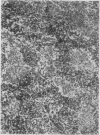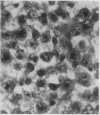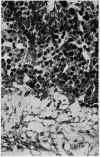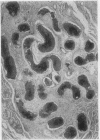Abstract
Stages in the retrogression of testicular seminoma are described. Eosinophilic necrosis fringed by palisaded histiocytes may be followed by fibrous replacement. Oxidation of unsaturated phospholipids in necrotic tumour may lead to deposition of lipofuscin around the lesion. Search for partially or completely scarred lesions is essential before contemplating a diagnosis of primary retroperitoneal seminoma.
Retrogressed seminoma can often be distinguished from retrogressed teratoid tumours. Apparently paradoxical teratoid metastases in association with a testicular seminoma are explained on the basis of misinterpreted retrogressed teratoid tumours in association with the seminoma.
Inguinal node metastases from testicular seminoma may be the result of abnormal lymphatic drainage following previous scrotal operations, testicular torsion etc.
Full text
PDF






Images in this article
Selected References
These references are in PubMed. This may not be the complete list of references from this article.
- AINSWORTH R. W., GRESHAM G. A. Primary chorioncarcinoma of the uinary bladder in a male. J Pathol Bacteriol. 1960 Jan;79:185–192. doi: 10.1002/path.1700790125. [DOI] [PubMed] [Google Scholar]
- AUVERT J. [A case of para-aortic lymph-node metastases of an undiscovered seminoma at the level of the testes]. J Urol Medicale Chir. 1960 Dec;66:800–809. [PubMed] [Google Scholar]
- AZZOPARDI J. G., MOSTOFI F. K., THEISS E. A. Lesions of testes observed in certain patients with widespread choriocarcinoma and related tumors. The significance and genesis of hematoxylin-staining bodies in the human testis. Am J Pathol. 1961 Feb;38:207–225. [PMC free article] [PubMed] [Google Scholar]
- AZZOPARDI J. G. Oat-cell carcinoma of the bronchus. J Pathol Bacteriol. 1959 Oct;78:513–519. doi: 10.1002/path.1700780218. [DOI] [PubMed] [Google Scholar]
- BOWLES W. T. Inguinal node metastases from testicular tumor developing after varicocelectomy. J Urol. 1962 Aug;88:266–267. doi: 10.1016/S0022-5347(17)64782-7. [DOI] [PubMed] [Google Scholar]
- FRIEDMAN N. B. The comparative morphogenesis of extragenital and gonadal teratoid tumors. Cancer. 1951 Mar;4(2):265–276. doi: 10.1002/1097-0142(195103)4:2<265::aid-cncr2820040211>3.0.co;2-x. [DOI] [PubMed] [Google Scholar]
- LYNCH M. J., BLEWITT G. L. Choriocarcinoma arising in the male mediastinum. Thorax. 1953 Jun;8(2):157–161. doi: 10.1136/thx.8.2.157. [DOI] [PMC free article] [PubMed] [Google Scholar]
- Laipply T. C., Shipley R. A. Extragenital Choriocarcinoma in the Male. Am J Pathol. 1945 Sep;21(5):921–933. [PMC free article] [PubMed] [Google Scholar]
- QUENU L. [Urography revealing a hidden and spontaneously regressing cancer of the testis]. J Urol Medicale Chir. 1960 Dec;66:861–862. [PubMed] [Google Scholar]
- RATHER L. J., GARDINER W. R., FRERICHS J. B. Regression and maturation of primary testicular tumors with progressive growth of metastases; a report of six new cases and a review of the literature. Stanford Med Bull. 1954 Feb;12(1):12–25. [PubMed] [Google Scholar]
- Stowell R. E., Sachs E., Russell W. O. Primary Intracranial Chorionepithelioma with Metastases to the Lungs. Am J Pathol. 1945 Jul;21(4):787–801. [PMC free article] [PubMed] [Google Scholar]
- WITUS W. S., SLOSS J. H., VALK W. L. Inguinal node metastases from testicular tumors developing after orchipexy. J Urol. 1959 May;81(5):669–671. doi: 10.1016/S0022-5347(17)66089-0. [DOI] [PubMed] [Google Scholar]









